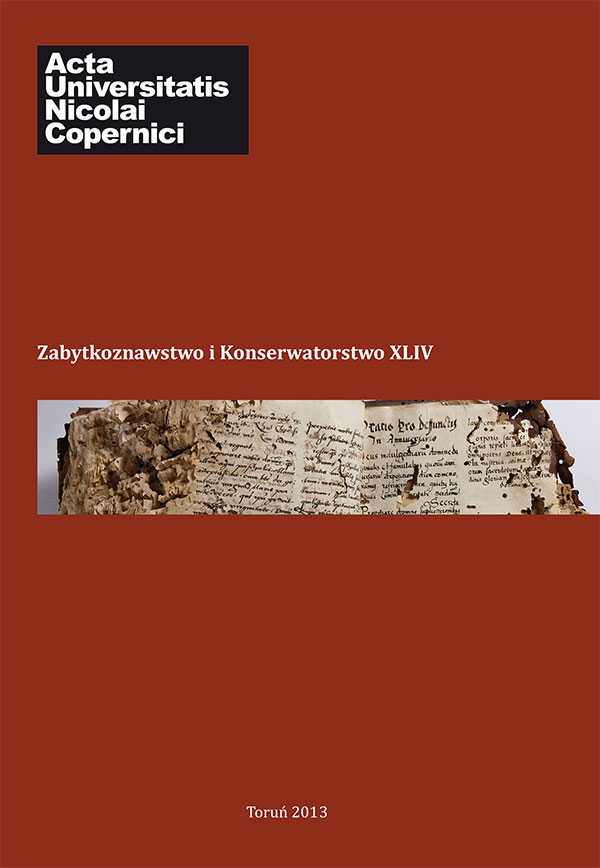„Atawistyczne zamiłowanie do materii” – o malarstwie Bronisława Kierzkowskiego i problematyce konserwatorskiej jego dzieł
DOI:
https://doi.org/10.12775/AUNC_ZiK.2013.018Abstrakt
The paper presents the issues concerning paintings by Bronisław Kierzkowski, who was developing his interest in such aspects as matter, space and texture in his works. Bronisław Kierzkowski is one of the exponents of the trend of matter painting, which was developing in the Polish art in the second half of the 20th century. Within this matter painting trend he created his own unique way of artistic expression. He executed a plasterworks series, the so-called Fakturowce – spatial compositions that became the prominent hallmark of his work. These relief-like paintings are works of art composed of two different kinds of matter – metal and plaster, which, by interpenetrating and interacting with each other, form spatial structures bordering between painting and sculpture. Various metal elements, such as perforated and unperforated stripes, production waste, wire meshes, wires, sometimes even pieces of glass or plastic had been embeded by Kierzkowski in wet plaster, which while drying out was perpetuating forms and shapes.
In addition to a brief characteristics of life and work of Bronisław Kierzkowski, the paper contains the analysis of Texture Composition nr. 532 from the Fakturowce series. On the example of that painting an attempt was made to recreate consecutive stages of creating the work of art, as well as to understand its complex structure. Moreover, the paper discusses selected issues of conservation of works of art from the Fakturowce series. Different causes of damage are pre sented. These are for example: unstable structure of paintings, combining ungalvanised iron and plaster into one work of art leading to corrosion of metal elements, complex structures of paintings resulting in mechanical damage, gaps and dust accumulation. The article draws attention to the issues of defining artists’ intentions and their impact on developing the program of conservation works in the context of modern art.
Pobrania
Opublikowane
Jak cytować
Numer
Dział
Licencja
CC BY ND 4.0. Posiadaczem prawa autorskiego (Licencjodawcą) jest Autor, który na mocy umowy licencyjnej udziela nieodpłatnie prawa do eksploatacji dzieła na polach wskazanych w umowie.
- Licencjodawca udziela Licencjobiorcy licencji niewyłącznej na korzystanie z Utworu/przedmiotu prawa pokrewnego w następujących polach eksploatacji: a) utrwalanie Utworu/przedmiotu prawa pokrewnego; b) reprodukowanie (zwielokrotnienie) Utworu/przedmiotu prawa pokrewnego drukiem i techniką cyfrową (e-book, audiobook); c) wprowadzania do obrotu egzemplarzy zwielokrotnionego Utworu/przedmiotu prawa pokrewnego; d) wprowadzenie Utworu/przedmiotu prawa pokrewnego do pamięci komputera; e) rozpowszechnianie utworu w wersji elektronicznej w formule open access na licencji Creative Commons (CC BY-ND 3.0) poprzez platformę cyfrową Wydawnictwa Naukowego UMK oraz repozytorium UMK.
- Korzystanie przez Licencjobiorcę z utrwalonego Utworu ww. polach nie jest ograniczone czasowo ilościowo i terytorialnie.
- Licencjodawca udziela Licencjobiorcy licencji do Utworu/przedmiotu prawa pokrewnego nieodpłatnie na czas nieokreślony
PEŁEN TEKST UMOWY LICENCYJNEJ >>
Statystyki
Liczba wyświetleń i pobrań: 317
Liczba cytowań: 0



